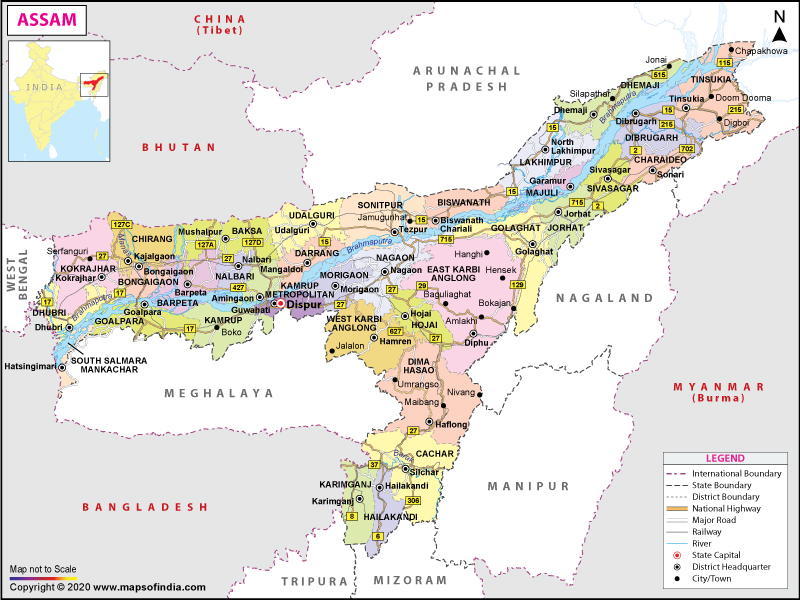ECI initiates delimitation in Assam
Context
-
The Election Commission of India said that, it has begun the process of delimitation of Assembly and Parliamentary constituencies in Assam.
-
The process will be based on Census data from 2001. The last delimitation of constituencies in Assam was done in 1976 on the basis of the 1971 Census.
-
About Delimitation
- Delimitation is the act of redrawing boundaries of Lok Sabha and state Assembly seats to represent changes in population.
- The main objective of delimitation is to provide equal representation to equal segments of a population.
- Delimitation of constituencies is periodically carried out to reflect not only an increase in population but changes in its distribution.
Who carries out delimitation?
- Delimitation is carried out by an independent Delimitation Commission, appointed by the Government of India under provisions of the Delimitation Commission Act.
- The Delimitation Commission is appointed by the President of India and works in collaboration with the Election Commission of India.
- It is composed of the following:
- a retired Supreme Court judge,
- the Chief Election Commissioner of India and
- respective State Election Commissioners.
- The Delimitation Commission is to work without any executive influence.
- The Constitution mandates that the Commission’s orders are final and cannot be questioned before any court as it would hold up an election indefinitely.
How is delimitation supposed to be carried out?
- Under Article 82, Parliament is to enact a Delimitation Act after every Census.
- Once the Act is in force, the Union government sets up the Delimitation Commission.
- The Commission is supposed to determine the number and boundaries of constituencies in a way that the population of all seats, so far as practicable, is the same.
- The Commission is also tasked with identifying seats reserved for Scheduled Castes and Scheduled Tribes.
- The draft proposals of the Delimitation Commission are published for public feedback.
- The Commission also holds public sittings. After hearing the public, it considers objections and suggestions, and carries out changes, if any, in the draft proposal.
- The final order is published in the Gazette of India and the State Gazette concerned and comes into force on a date specified by the President.

How have previous delimitation exercises actually worked?
- In the history of the Indian republic, Delimitation Commissions have been set up four times 1952, 1963, 1973 and 2002 under the Acts of 1952, 1962, 1972 and 2002.
- There was no delimitation after the 1981, 1991 and 2001 Censuses.
- However, the 2002 Act did not make any changes in total Lok Sabha seats or their apportionment between various states.
- It also left out a few states including Assam, Arunachal Pradesh, Nagaland and Manipur from the exercise due to “security risks.”
- The central government reconstituted the Delimitation Commission for these four states as well as the union territory of Jammu and Kashmir on 6 March 2020.
Why have we not seen delimitation exercises after each census?
- The last delimitation exercise that changed the state-wise composition of the Lok Sabha was completed in 1976 and done on the basis of the 1971 census (more than half a century ago at this point).
- The reason for not having more frequent delimitation processes is an unintended consequence of how the Constitution envisioned constituencies to be delimited.
- The Constitution mandates that the number of Lok Sabha seats allotted to a state would be such that the ratio between that number and the population of the state is, as far as practicable, the same for all states.
- However, this provision meant that states that took little interest in population control could end up with a greater number of seats in the Parliament.
- The fear of losing meaningful political representation was especially great in the southern states which not only had had greater success in controlling populations but also economically developed such that they generated a lot more per capita revenue than the northern states.
- Delimitation on the basis of population would disenfranchise them politically while the central government would continue to benefit from these states’ economic contributions to the country.
- To allay these fears, the Constitution was amended during Emergency rule in 1976 to suspend delimitation until 2001.
- Another amendment postponed this until 2026.
- It was hoped that the country would achieve a uniform population growth rate by this time.
How has the news of the new delimitation process been received in Assam?
- While most have welcomed the delimitation process, saying it was long overdue, some have raised concern for using the 2001 census for the process rather than the 2011 one. The 2021 census is yet to be carried out.
- It was due long back… After 2011 and 2021, if we go by 2001, it will be an injustice to follow the 2001 Census figures. Before taking such a decision, the government should consider whether it will serve any meaningful purpose.
Source: IE
Visit Abhiyan PEDIA (One of the Most Followed / Recommended) for UPSC Revisions: Click Here
IAS Abhiyan is now on Telegram: Click on the Below link to Join our Channels to stay Updated
IAS Abhiyan Official: Click Here to Join
For UPSC Mains Value Edition (Facts, Quotes, Best Practices, Case Studies): Click Here to Join
